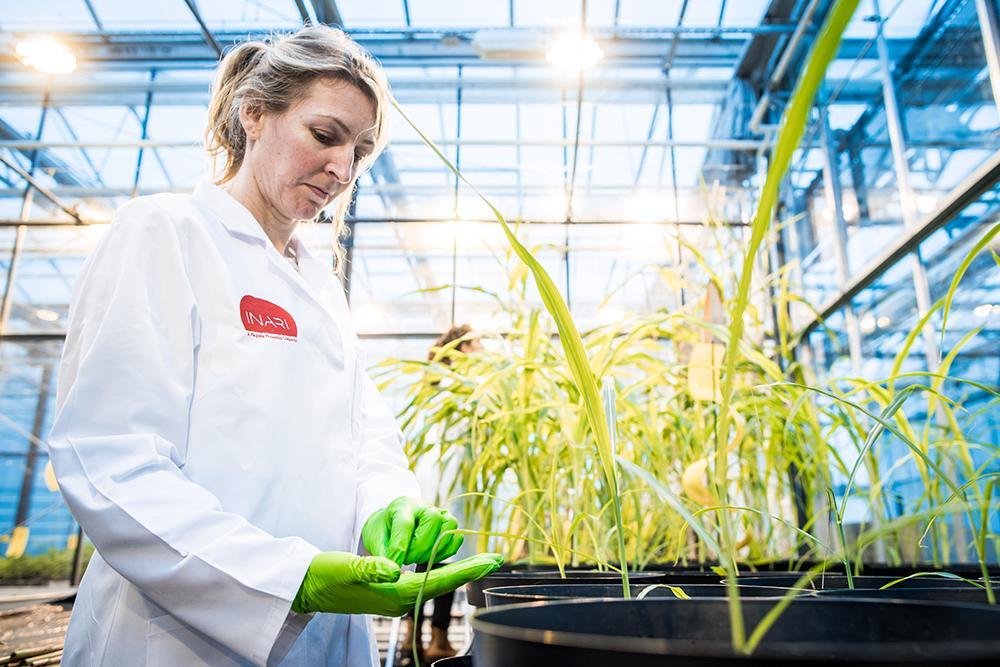Inari
USA

The following is an interview with Benjamin Jayne, Laboratory Operations Manager at Inari Agriculture in Cambridge, Massachusetts.
Tell me a little bit about what events or business goals led Inari to using the Conviron growth chambers?
Benjamin: Early on, we leased greenhouse space from Harvard University. It was a modestly sized greenhouse, but it gave us the opportunity to grow plants to maturity because we were harvesting the power of the sun. Part of that lease agreement included six reach-in Conviron chambers. Even though they were older pieces of equipment, they were absolutely the best we had worked with. They provided the flexibility we needed to grow a variety of plants in various stages of growth. The greenhouse wasn’t optimal because it was east facing. Even in the summer the light was blocked by the center wall for a period of time each afternoon. Those Conviron chambers had the movable light ballasts, and you can fit a lot of little pots into a space that large. And because you could control the environmental conditions so precisely, it was really ideal for the number and type of experiments we were doing.
As Inari grew and we expanded to Indiana, to be closer to our customers, we no longer needed the greenhouse in Cambridge. However, Conviron really remained part of our permanent ecosystem.
The beauty of Conviron is in its very precise environmental controls. In our testing, they were rarely out of our setpoints by more than half a degree Celsius.
Inari’s Path to Controlled Growth
The founders of Inari set out to “transform the global food system.” The biotech company with facilities in Cambridge, Massachusetts, West Lafayette, Indiana, and Ghent, Belgium, focuses primarily on seed design in an effort to increase yield, limit water and nitrogen required and decrease the price of seed for farmers. The main goal is to transform the global food system by developing step-change products that lead to more productive acres and a more sustainable future for the food system.
Conviron plant growth chambers have played an integral role in the company’s innovation efforts at it’s US facilities. This includes two PGC-FLEX chambers installed at the Cambridge R&D facility in 2019 and seven walk-in chambers at the West Lafayette production site.
Here, Benjamin Jayne, Lab & Site Manager at the Cambridge location, shares how Inari has grown since its founding in 2016, and the key enabling technologies behind the company’s success.
Can you tell me a little bit about some of the projects you’ve been working on and how the chambers fit into them?
Benjamin: The most important thing is the diversity of conditions we were afforded by having multiple chambers for our use. One of our early projects was working with wheat. Of the three crops we focus on, it is the most unique. It likes temperatures that are cooler than what corn and soybeans like. We might want to grow corn at 28 degrees Celsius. That’s way too warm for wheat. Wheat is going to be between 15-20 degrees. It’s really difficult when you have a wide open space like a greenhouse or a very large grow room to cultivate two different crops optimally. The beauty of Conviron is in its very precise environmental controls. In our testing, they were rarely out of our setpoints by more than half a degree Celsius. It’s robust equipment that’s dependable and fairly intuitive. We could set it up for what we wanted to do and sort of walk away from it.
You mentioned that you’ve expanded into Indiana. How are you using the chambers in that facility?
Benjamin: Our West Lafayette facility was formerly used by a large ag/biotech company and was well aligned with our needs. It features a regulatory-approved greenhouse controlled by an Argus system. The lab spaces also had a number of large walk-in Conviron chambers, which are primarily used for tissue culture. I recently spoke with our science technology group, and they have ordered three more large walk-in Conviron chambers. So it’s equipment that we recognize as the gold standard in controlled-environment plant growth, and we don’t want to look back.
What’s significant about the type of work going on at Inari?
Benjamin: Inari is on the cusp of something important, which is our ability to make multiple, targeted edits of a plant’s genome to deliver benefits to farmers, consumers and the environment. Our technology is enabled by artificial intelligence, which creates a deep understanding of the genome, then our powerful combination of gene editing tools is used to make the desired changes. Inari is unique in that ability to make multiple edits to the plant at the same time.
We also leverage a unique mix of disciplines and people, combining deep experience within our own sector with high level expertise from across science and technology — from biology to physics to agronomy to computer science — to expand our capacity for innovation.
